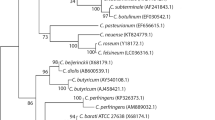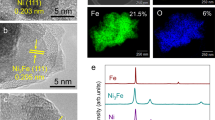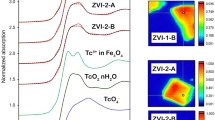Abstract
A Citrobacter sp. accumulates uranyl ion (UO22+) as crystalline HUO2PO4 · 4H2O (HUP), using enzymati-cally generated inorganic phosphate. Ni was not removed by this mechanism, but cells already loaded with HUP removed Ni2+ by intercalative ion-exchange, forming Ni(UO2PO4)2 · 7H2O, as concluded by x-ray diffraction (XRD) and proton induced x-ray emission (PIXE) analyses. The loaded biomass became saturated with Ni rapidly, with a molar ratio of Ni:U in the cellbound deposit of approx. 1:6; Ni penetration was probably surface-localized. Cochallenge of the cells with Ni2+ and UO22+, and glycerol 2-phosphate (phosphate donor for phosphate release and metal bioprecipitation) gave sustained removal of both metals in a flow through bioreactor, with more extensively accumulated Ni. We propose ‘Microbially Enhanced Chemisorption of Heavy Metals’ (MECHM) to describe this hybrid mechanism of metal bioaccu-mulation via intercalation into preformed, biogenic crystals, and note also that MECHM can promote the removal of the transuranic radionuclide neptunium, which is difficult to achieve by conventional methods.
This is a preview of subscription content, access via your institution
Access options
Subscribe to this journal
Receive 12 print issues and online access
$209.00 per year
only $17.42 per issue
Buy this article
- Purchase on Springer Link
- Instant access to full article PDF
Prices may be subject to local taxes which are calculated during checkout
Similar content being viewed by others
References
Macaskie, L.E., Empson, R.M., Cheetham, A.K., Grey, C.P. and Skarnulis, A.J. 1992. Uranium bioaccumulation by a Citrobacter sp. as a result of enzymically-mediated growth of polycrystalline HUO2PO4. Science 257: 782–784.
Macaskie, L.E., Bonthrone, K.M. and Rouch, D.A. 1994. Phosphatase-mediated heavy metal accumulation by a Citrobacter sp. and related enterobacteria. FEMS Microbiol. Lett. 121: 141–146.
Macaskie, L.E. and Dean, A.C.R. 1982. Cadmium accumulation by micro-organisms. Environ. Technol. Lett. 3: 49–56.
Macaskie, L.E. 1990. An immobilized cell bioprocess for the removal of heavy metals from aqueous flows. J. Chem. Technol. Biotechnol. 49: 357–379.
Clark, P.J., Shama, G. and Streat, M. 1992. in Bioprecipitation of metals from wastewaters. Inst. Chem. Eng. Res. Event, UMIST, UK. pp. 308–311.
Macaskie, L.E., Jeong, B.C. and Tolley, M.R. 1994. Enzymically-accelerated biomineralization of heavy metals: application to the removal of americium and plutonium from aqueous flows. FEMS Microbiol. Rev. 14: 351–368.
Macaskie, L.E., Empson, R.M., Lin, F. and Tolley, M.R. 1995. Enzymatically-mediated uranium accumulation and uranium recovery using a Citrobacter sp. immobilized as a biofilm within a plug-flow reactor. J. Chem. Technol. Biotechnol. 63: 1–16.
Sittig, M. (ed.). 1975. in Environmental Sources and Emissions Handbook. Noyes Data Corp, New Jersey. p. 97.
Macaskie, L.E. 1991. The application of biotechnology to the treatment of wastes produced from the nuclear fuel cycle: biodegradation and bioaccumulation as a means of treating radbnuclide-contaminated streams. CRC Grit. Rev. in Biotechnol. 11: 41–112.
Patterson, J.W. 1985. in Industrial Wastewater Treatment Technology. Butterworth, Boston. p. 217.
Bhattacharyya, D. and Cheng, C.Y.R. 1987. Activated carbon adsorption of heavy metal chelates from single and multicomponent systems. Envir. Prog. 6: 110–118.
Zouboulis, A.I. and Kydros, K.A. 1993. Use of red mud for toxic metals removal—the case of nickel. J. Chem. Technol. Biotechnol. 58: 95–101.
Corder, S. and Reeves, M. 1994. Biosorption of nickel in complex aqueous waste streams by Cyanobacteria. Appl. Biochem. Biotechnol. 45/46: 847–859.
Volesky, B. (ed.). 1991. Biosorption of Heavy Metals. CRC Press, Boca Raton, USA.
Tsezos, M., Remoudaki, E. and Agelatou, V. 1995. A systematic study on equilibrium and kinetics of biosorptive accumulation.The case of Ag and Ni. Int. Biodeterior. Biodegr. 35: 129–154.
Kumar, C.H.S., Sastry, K.S. and Mohan, P.M. 1992. Use of wildtype and nickel resistant Neurospora crassafor removal of Ni2+ from aqueos medium. Biotechnol. Lett. 14: 1099–1202.
Diels, L., Van Roy, S., Taghavi, S., Doyen, W., Leysen, R. and Mergeay, M. 1993. The use of Alcaligenes eurotrphus immobilized in a tubular membrane reactor for heavy metal recuperation, in Biohydrometallurgicat Technologies. Torma, A. E. et al. (eds.). Proc. Int. Symp. Biohydrometallurgy, Jackson Hole, Wyoming, August 1993. The Minerals, Metals and Materials Society, USA. pp. 133–144.
Macaskie, L.E., Hewitt, C.J., Shearer, J.A. and Kent, C.A. 1995. Biomass production for the removal of heavy metals from aqueous solution at low pH using growth-decoupled cells of a Citrobacter sp. Int. Biodeter. Biodegr. 35: 73–92.
Dean, J.A. (ed.). 1992. Lange's Handbook of Chemistry, 14th ed. McGraw-Hill, New York.
Good, N.G., Winget, G.D., Winter, W., Connolly, T.N., Izawa, S. and Singh, R.M.M. 1966. Hydrogen ion buffers for biological research. Biochemistry 5: 467–477.
Baes, C.F. and Mesmer, R.E. 1976. The Hydrolysis of Cations. Wiley, New York.
Fu-Sheng, W., Pei-Hua, Q., Nai-Kui, S. and Fang, Y. 1989. Sensitive spectrophotometric determination of nickel(ll) with 2-(5-bromo-2-pyridylazo)-5-diethylaminophenol. Talanta 28: 189–191.
Torrance, K. 1984. Determination of ionic nickel and cobalt in simulated PWR coolant by differential-pulse polarography. Analyst 109: 1035–1038.
Hughes, M.N. and Poole, R.K. 1991. Metal speciation and microbial growth—the hard (and soft) facts. J. Gen. Microbiol. 137: 725–734.
Morosin, B. 1978. Hydrogen uranyl phosphate tetrahydrate, a hydrogen solid electrolyte. Acta Cryst. 634: 3732–3734.
Hunsberger, L.R. and Ellis, A.B. 1990. Excited-state properties of lamellar solids derived from metal complexes and hydrogen uranyl phosphate. Coord. Chem. Rev. 97: 209–224.
Pozas-Torma, R., Moreno-Real, L., Martinez-Lara, M. and Bruque-Gamez, S. 1986. Layered metal phosphates, retention of divalent ions by amine intercalates of uranyl phosphates. Can. J. Chem. 64: 30–34.
Pozas-Torma, R., Bruque-Gamez, S., Martinez-Lara, M. and Moreno-Real, L. 1988. Interlayer ammine complexes of metal uranyl phosphate. Can. J. Chem. 66: 2849–2854.
Powder diffraction file Card No. 29-670,1992. JCPDS, Swarthmore, PA.
Powder diffraction file Card No. 35-317,1992. JCPDS, Swarthmore, PA.
A part of the DIFFRAC-AT V3.2 program written by SOCABIM for SEAMMAN, June 1993.
Grime, G.W., Dawson, M., Marsh, M., McArthur, I.C. and Watt, F., 1991. Oxford submicron nuclear microscopy facility. Nucl. Inst. Meth. 854: 52–63.
Johannson, S.A.E. and Campbell, J.L. 1988. PIXE—a Novel Technique for Elemental Analysis. Wiley, Chichester, U.K.
Watt, F. and Grime, G. (eds.). 1989. Principles and Applications of High Energy Ion Microbeams. Hilger, Bristol, U.K.
Tamana, H., Griddle, A., Grime, G.W., Vaughan, D. and Spratt, J. 1994. Trace elements in platinum group minerals studied using nuclear microscopy. Nucl. Instr. Meth. 89: 213–218.
Langford, J.I. 1973. The accuracy of cell dimensions determined by Cohen's method of least squares and the systematic indexing of powder data. J. Appl. Cryst 6: 190–196.
Langford, J.I. 1971. Powder pattern programs. J. Appl. Cryst. 4: 259–260.
Tolley, M.R. and Macaskie, L.E. 1971. Metal removal from aqueous solutions. Patent application pet No. GB94/00626.
Tolley, M.R. 1993. The biological treatment of liquid wastes containing heavy metals. D. Phil Thesis, University of Oxford, U.K.
Rosenthal, G.L. and Ellis, A.B. 1988. Structural and photoluminescent properties of fully-hydrated lanthanon uranyl phosphates. J. Less Comm. Met. 139: 299–304.
Dorhout, P.K., Kissane, R.J., Abney, K.D., Eller, R.G., and Ellis, A.B. 1989. Intercalation reactions of the neptunyl (VI) dication with hydrogen uranyl phosphate and hydrogen neptunyl phosphate host lattices. Inorg. Chem. 28: 2926–2930.
Tolley, M.R., Strachan, L.F. and Macaskie, L.E. 1995. Lanthanum accumulation from acidic solutions using a Citrobacter sp. immobilized in a flow-through reactor. J. Ind. Microbiol. 14: 271–280.
Author information
Authors and Affiliations
Rights and permissions
About this article
Cite this article
Bonthrone, K., Basnakova, G., Lin, F. et al. Bioaccumulation of nickel by intercalation into polycrystalline hydrogen uranyl phosphate deposited via an enzymatic mechanism. Nat Biotechnol 14, 635–638 (1996). https://doi.org/10.1038/nbt0596-635
Received:
Accepted:
Issue Date:
DOI: https://doi.org/10.1038/nbt0596-635
This article is cited by
-
Multimetal bioremediation and biomining by a combination of new aquatic strains of Mucor hiemalis
Scientific Reports (2019)
-
The biogeochemical fate of nickel during microbial ISA degradation; implications for nuclear waste disposal
Scientific Reports (2018)
-
Genetics of phosphate solubilization and its potential applications for improving plant growth-promoting bacteria
Plant and Soil (2006)
-
A New Method for Mercury Removal
Biotechnology Letters (2005)
-
Developments in Bioremediation of Soils and Sediments Polluted with Metals and Radionuclides – 1. Microbial Processes and Mechanisms Affecting Bioremediation of Metal Contamination and Influencing Metal Toxicity and Transport
Reviews in Environmental Science and Bio/Technology (2005)



